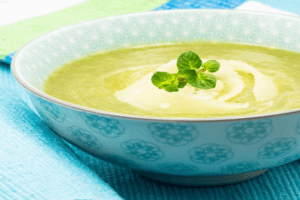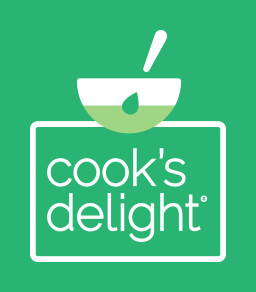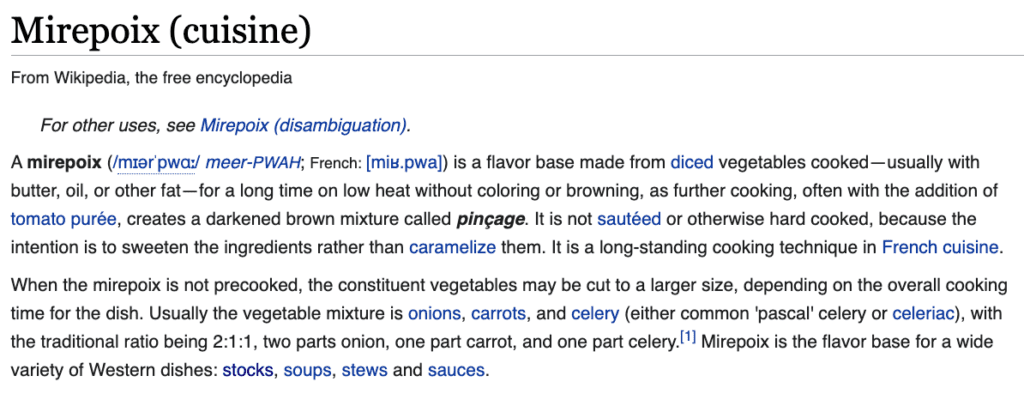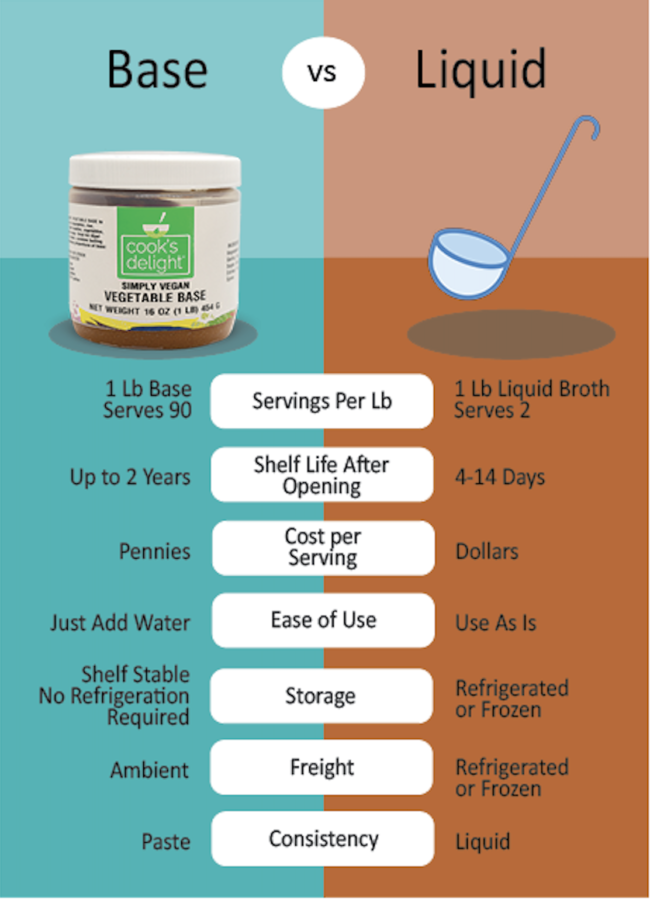How Are Vegetable Base, Stock, Broths and Bouillon Made?
In search of healthy meal options for vegetarians, vegans, plant-based diet followers or simply veggie lovers? A great starting point is vegetable bases, broths, stocks and bouillon.
The process for making vegetable stock from scratch is a simple one:
-
- Cut-up vegetables.
- Cover vegetables with water in a large stockpot.
- Bring to a boil, reduce heat and simmer uncovered for 2-3 hours.
- Strain any solids. You may need to strain more than once.
Optional Step: After vegetables are cut up (step 1), sauté vegetables in oil over low heat or bake until vegetables are slightly brown on the edges. This produces a darker color and stronger taste.
A vegetable base is simply a concentrated version of a vegetable stock or base where more of the water has been allowed to evaporate while simmering. Bouillon is a dehydrated broth or stock formed into a small cube. Check out more detailed definitions of these terms in What is the Difference Between Chicken Base and Chicken Stock or Chicken Broth?
Which Vegetables Are Best For Vegetable Bases, Stock, Broth and Bouillon?
Most often, a combination of carrots, onions and celery called Mirepoix (pronounced Meer-PWAH) is used as a standard flavoring base for vegetable bases, stocks, broths and bouillon. However, this basic flavoring preparation is also used for other dishes including soups, sauces, meats, poultry and fish.
According to Wikipedia, the word mirepoix “dates from the 18th century and derives, as do many other appellations in French cuisine, from the aristocratic employer of the cook credited with establishing and stabilizing it, Gaston-Pierre-Charles de Lévis-Lomagne, duc de Mirepoix (1699–1757)
There Are Plenty of Other Vegetables To Add To Vegetable Base, Stock and Broth:
Carrots Onions Mushrooms Garlic Tomatoes Mushrooms Turnip Greens Leeks Zucchini Shallots Green Beans Okra There’s a lot of flexibility in which vegetables you choose and the proportions you add them in. Want a dominant flavor? Add more of your choice of vegetable and less of more neutral vegetables, such as onion and carrots.
Remember, vegetable stock, broth and base are great ways to use up kitchen scraps including peels, skins, stems and other vegetable leftovers.
Some Vegetables Just Don’t Make the Cut:
When making your own vegetable stock or broth, avoid starchy vegetables since they can make a broth or stock cloudy; such as:
- potatoes
- sweet potatoes
- pumpkin
- squash
- beets can turn it red.
Others vegetables are too overpowering:
- Brussels sprouts
- cauliflower
- artichokes
- peppers
- radishes and more
Be careful not to add vegetables that turn bitter when cooked for a long period of time, such as spinach, broccoli, kale, cabbage and collard greens.
Vegetable Stock, Broth and Base Are Healthy Choices For A Plant-Based Diet
According to Wikipedia, “a plant-based diet is a diet consisting mostly or entirely of foods derived from plants and with few or no animal-source foods. A plant-based diet is not necessarily vegetarian.[3] The use of the phrase “plant-based” has changed over time and examples can be found of the phrase “plant-based diet” being used to refer to vegan diets, which contain no food from animal sources, and vegetarian diets, which may include dairy or eggs but no meat,[5] as well as diets with varying amounts of animal-based foods, such as semi-vegetarian diets.
Plant-Based Diets Are Growing Like Weeds!
According to www.healthcareers.com,
- Veganism was the top consumer trend in 2018. This was driven mostly by Millennials, with a quarter of American 25-34 year-olds declaring to be vegan or vegetarians.
- 6% of Americans claim that they don’t consume meat, which is a 600% increase compared to 2014.
- 4% are vegetarians
- 2% are vegans
- Roughly 40 percent of North America consumers are trying to include more vegan ingredients in their diets.
- 1 in 3 Americans now identities as “flexitarian” (people who are primarily vegetarians but occasionally eat meat or fish).
- 5.9% of the European population is either vegetarian or vegan.
Plant-Based Diets Are Here To Stay!
By 2025, the global vegan meat market will reach 7.5 billion.
By 2040, only 40 percent of the global population will consume meat. (https://healthcareers.co/vegan-statistics/)
Plant-Based Have Taken Root!
A new study has revealed that the number of Americans following plant-based diets is up nearly 9.4 million over the last 15 years to over 9.7 million in total.www.thebeet.com
- In 2018, the global vegan food market was worth $12.7 billion
- The vegan food market will reach $24.06 billion in 2025
- In 2026, it will reach 24.3 billion. (https://healthcareers.co/vegan-statistics/)
Why Choose To Use Vegetable Base Instead of Vegetable Stock Or Broth?
- Using vegetable base allows you to make the exact amount needed for a recipe without having leftover liquid stock that will spoil if not used.
- Liquid vegetable stock lasts 4-14 days, depending on the stock. Vegetable base has a shelf-life of up to 2 years.
- Ideal for recipes that need less liquid but added flavor.
- Spend pennies per serving for vegetable base compared to vegetable stock or broth.
- Get 90 servings with one pound of vegetable base and only two servings with one pound of pre-packaged liquid stock or broth.
- Save on warehouse, cooler and freezer base with veggie base. A 50-lb pail of soup base takes up less space than the equivalent 283 gallons of soup broth or stock.
How do you make vegetable base into a substitute for pre-packaged vegetable stock or broth? Just add water! Simply mix ¾ teaspoon of vegetable base with 8 ounces of water. One pound of vegetable base converts into 5 ½ gallons of vegetable stock or broth – a total of twenty-two 32-oz. boxes!
How Can Vegetable Base Be Used?
Vegetable base converted into vegetable stock/broth can be used as a flavorful replacement for water in a recipe.
Add vegetable base to pasta, casseroles, dips, sauces – any dish that you want to enhance flavor.
Vegetable base is a great substitute for chicken base in recipes too. It makes a delicious vegetable soup of, course, and is often the foundation for many other soups including lentil, broccoli cheese, bean and minestrone.
Is All Vegetable Stock Vegan?
Vegans attempt to exclude all foods of animal origin from their diets. Vegetable stock is not necessarily vegan. It is important to read the ingredient statement. If the stock includes ingredients such as dried whey, honey, butter, casein, lactose, to name a few ingredients, it is not vegan.
Below is a list of available Cook’s Delight® Vegan Stock bases. Mix with boiling water to make instant vegetable stock.
Looking For A Few More Vegetable Base Recipe Ideas? Check These Out!
 |
 |
 |
| Spanish Rice Recipe | Cream of Celery Soup | Quinoa and Garbanzo Bean Salad |
Vegetable Bases offer a versatility to serve many diners with dietary restrictions.
Cook’s Delight® vegetable bases provide chefs and home cooks the versatility to substitute meat base in recipes for vegan and vegetarian alternatives. Chefs can use vegan chicken, vegan au jus and red bell pepper, chipotle or roasted garlic concentrates. The possibilities are only limited by your imagination!”
Georgeann Quealy
President / Integrative Flavors
Who Uses Vegetable Base?
Soup base works in all recipes from home kitchens, to foodservice operations to industrial formulas! Soup bases and flavor concentrates give your recipes a consistent, predictable flavor profile. Take the guesswork out of quality management and save labor, too. Convenient pack sizes and shelf stable products allow users to source the amount needed without worrying about shortage or storage.
Health trends change and so do our products. With the addition of our new line of Zero Sugar Bases, Cook’s Delight® provides an option for professional chefs wanting to control the sugar in their culinary creations. Available in chicken, beef and vegetable (both organic and conventional) varieties, the bases are gluten free with no MSG, no Big 8 allergens and no trans fats. These clean label products conform to the guidelines of many popular zero sugar diets as well as KETO, vegan and low carb.
Submit a request for your sample. These bases are a perfect addition to your distribution product line, especially if healthcare providers are a key demographic in your customer base.







